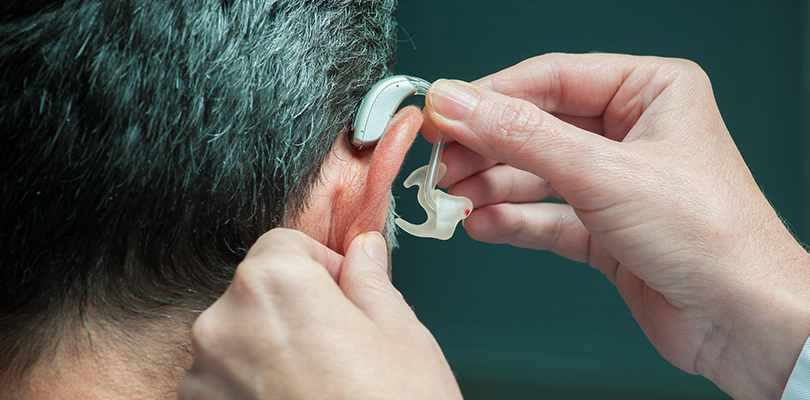Everything You Should Know About Hearing Aids
Hearing loss impacts 38 million Americans – that is a significant amount of the population that experiences the many challenges that hearing loss creates.
Not being able to hear properly can impact your job, your personal life, and your overall well-being. If you also have difficulty with hearing, it is time to consider the many benefits of hearing aids.
Not only can hearing aids restore your hearing so that you can be an active participant in your life, but leading innovation makes it easier to find the best device to suit your lifestyle.
How Hearing Aids Work
For people new to hearing aids, it is important to take a minute to understand how they work. All digital hearing aids are equipped with the same basic components:
- Microphone – picks up the sound
- Computer chip – processes and amplifies the sound
- Speaker – sends the sound to the ear
- Battery – powers the device
While the basic set-up is the same, there are many, many options when it comes to the style. A hearing aid professional will be able to assist you with finding the best style for your specific needs.
Style of Hearing Aids
There are two basic styles of hearing aids which are in-the-ear (ITE) and behind-the-ear (BTE). Each group offers a variety of sizes and slight alterations.
ITE hearing aids are an attractive option simply because they have the longest reputation of being most discreet. This type of hearing aid has a fit that ranges from virtually invisible to encompassing the entire ear.
Typical ITE Options include:
- Invisible-in-the-canal – This is the smallest style of hearing aid available. Because of its size, it can fit deep into the ear canal and is not visible. This style is intended for individuals who suffer from minor to moderate hearing loss
- In-the-canal – The advantage of this style is that it can accommodate various ranges of hearing loss. It is larger than the previous option, but a bigger battery indicates a longer use time. The hearing aid situates on the lower outer bowl of the ear which is visible but is designed for comfort.
- Low profile – This style is ideal for people who have dexterity issues. The size and features allow for simpler use. Low profile hearing aids can fit either half or the entire outer ear bowl. Preferences are usually based on how comfortable the person is with the fitting.
- Disposable hearing aids – A new phenomenon that was developed by Songbird Hearing Inc., an American company that wanted to produce a convenient, affordable product for a broad range of consumers. The disposable aid comes with a built-in battery and after the allotted hour or time usage, the user simply replaces the entire hearing aid.
BTE styles are considered the more traditional look of hearing aid. While there has been a lull in popularity, recent years there has been an increase in interest due to the vast changes in technology and comfort that this design offers.
Standard BTE options:
- Mini BTEs – This design is incredibly popular because it mostly hides behind the outer ear. Many people prefer this style, and it is now available for a broad range of hearing loss needs.
- Receiver-in-the-ear – This option includes a speaker built into the tip of the hearing aid while the rest of the components are situated behind the ear. This particular setup allows for better sound transmission for even for the hardest of hearing individuals.
- BTEs with earmolds – This style can include more controls than any other hearing aid option. It is designed to assist with a broad range of hearing needs and the shape contours to the natural shape of the outer ear.
Deep vein thrombosis is what happens when blood clots form in the deep veins. Here are deep vein thrombosis symptoms to watch for.
There is also a third option, hearing implants. The purpose of implantable hearing aids and cochlear implants is not to make a person hear normal again.
Rather, they have revolutionized ways to stimulate and/or better amplify sound. Because each recipient has a different degree and type of hearing loss, all implants work differently for every person. Implant recipients are those who for a variety of reasons do not benefit from or cannot wear hearing aids.
- Cochlear implants are surgically implanted into a person's inner ear. External components are either body-worn or behind the ear. The external component sends signals to the implant through the skin, which are then recognized as sound by the brain instantaneously. The process sends sound in the ear through nerve stimulation by avoiding damaged cells and by using an electrical signal.
- Bone anchored hearing aids (BAHA) – BAHAs transfer sound through a bone in the skull directly into the cochlea through a 'bone-conduction' process. A small device is implanted surgically behind the ear in the skull of the recipient. A case is located externally which holds a microphone and a sound processor. This case transmits sound to the bone which goes directly to the cochlea.
- Middle ear implants (MEI) – A device is planted into the middle ear through surgery. The implant works in conjunction with an external case that can be worn behind the ear or sometimes in the ear. The process works by vibrating the bones in the middle ear. MEI implants work well because they keep the ear canal and ear unblocked. MEI candidates can have a mild to profound loss of sensorineural hearing.
Other Considerations
There is much more to consider beyond the style that you prefer. Other factors you should think about:
- Budget – If funds are limited then a professional can assist you in finding the perfect hearing aid style that won’t break the bank.
- Needed accessories – Depending on the severity of your hearing loss, you may need more accessories and features.
- Cosmetic preferences – Some people are incredibly self-conscious of the look of certain hearing aids. Rest-assured some designs are virtually invisible!
- Lifestyle – Factors such as your job, your social preferences, and even hobbies can play a significant role in the best hearing aid for you.
Benefits of Improved Hearing Aids
Over the years, hearing aid development has indeed come a long way. Such improvements may include:
- Broader range of designs and styles
- Less noise/feedback issues
- Better sound quality
- Bluetooth capability listed in some designs
- Some hearing aids can isolate only the sounds you want to hear
Now, people are experiencing a higher quality hearing experience than ever before! Plus, with so many options people are finding the best match for their needs instead of settling for a one-size-fits-all approach.
Next Steps
If you are suffering from hearing loss, know that there is a solution for you. A hearing aid professional can help by walking you through the process so that you can find the best hearing aid for your specific needs.
You do not have to spend another minute with less-than-perfect hearing. Contact a professional to see which hearing aid works best for you.







